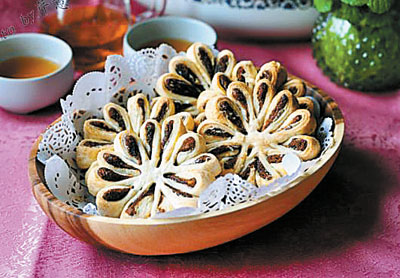|

Zee Wong
zedwong@163.com
AS far back as 15 B.C., chrysanthemum was used as a flowering herb for detoxification and enhancing eyesight. Chrysanthemum adds a slightly sweet flavoring to cake, wine, and tea. Chrysanthemum cake has a delicate and smooth texture and exudes a refreshing fragrance. We eat chrysanthemum cake on Double Ninth Day, the ninth day of September of the lunar calendar.
The legendary story for Double Ninth Day says that as early as the Eastern Han period (25-220), a demon emerged each year from the Ruhe River, a tributary of the Huaihe River that runs through today’s Anhui and Henan provinces, and killed many people with a dreadful plague. A young man named Hengjing was shattered by the plague. His parents died and he was close to death. When he recovered from the illness, Hengjing left his wife and village to seek revenge.
After many twists and turns, Hengjing learned sword techniques from an elderly Taoist man. Before Hengjing returned to his hometown, the old man gave Hengjing a magic sword, a pack of dogwood leaves and a jar of chrysanthemum wine for distribution to the villagers Sept. 9.
Hengjing distributed the supplies to the villagers and asked them to hide in the mountain. As usual, the demon made his way to the mountain, but halfway up, he was intimidated by the smell of dogwood and chrysanthemum wine. While the demon was distracted, Hengjing killed him with the magic sword.
From that day on, Sept. 9 was known as Double Ninth Day. Families go hiking with dogwood leaves, eat foods made of chrysanthemum, and visit deceased family members. As public interest grew in caring for the elderly, Double Ninth Day evolved to become a day of caring and showing respect to the elderly.
Double Ninth Day has a more traditional name also, “Chongyang Festival.” “Chong” means double, and “yang” is the same character as the one in “yin-and-yang,” which is commonly depicted as the Taijitu (diagram of supreme ultimate). “Yin-and-yang” is a Taoist concept and the core of “Yijing,” also known as “I Ching.” “Yijing” influenced the fundamental studies of the Chinese military, philosophy, medicine, etc.
In fact, “yin-and-yang” refers to the existence of the opposites in harmony. Furthermore, as yin reaches its extreme, it decays. Until yin disappears, yang emerges.
The concept of “yin-and-yang” exists not only in the nature, but also in numbers. According to “Yijing,” the number six is yin and the number nine is yang. Coincidentally, 69 looks like the Taijitu. Since Chongyang Festival is a day of two nines, it reaches the extreme of yang and it is at the verge of alternating. This explains why the legend is staged at Chongyang Festival.
Zee Wong is a Chinese student at Carnegie Mellon University who is also offering an innovative course in Chinese language and culture to multinational students and professionals.
|

